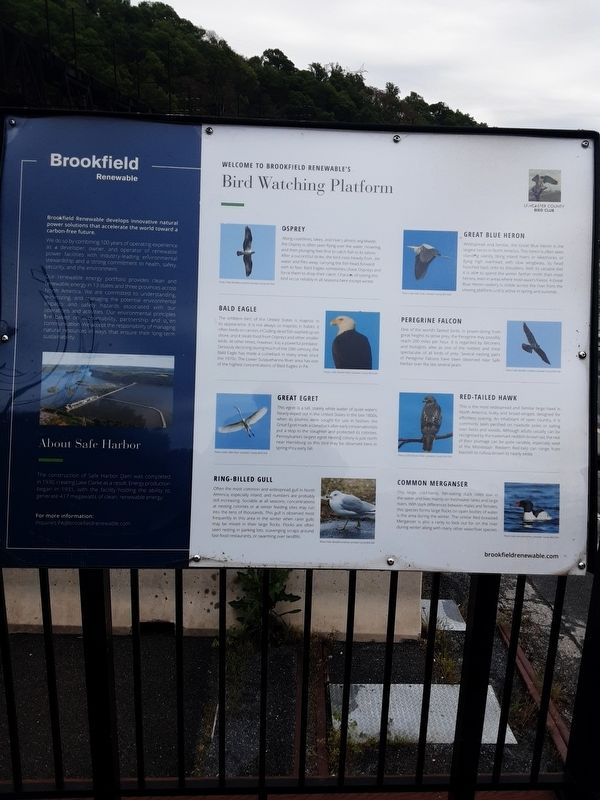Near Conestoga in Lancaster County, Pennsylvania — The American Northeast (Mid-Atlantic)
Bird Watching Platform
Brookfield
Renewable
Brookfield Renewable develops innovative natural power solutions that accelerate the world toward a carbon-free future.
We do so by combining 100 years of operating experience as a developer, owner, and operator of renewable power facilities with industry-leading erivironmental stewardship and a strong commitment to health, safety, security, and the environment.
Our renewable energy portfolio provides clean and renewable energy in 13 states and three provinces across North America. We are committed to understanding, minimizing, and managing the potential environmental impacts and safety hazards associated with our operations and activities. Our environmental principles åre based on accountabity, partnership and often communication. We accept the responsibility of managing natural resources in ways that ensure their long-term sustainability.
About Safe Harbor
The construction of Safe Harbor Dam was completed in 1930, creating Lake Clarke as a result. Energy production began in 1931, with the facility holding the ability to generate 417 megawatts of clean, renewable energy.
For more information:
[email protected]
Welcome to Brookfield Renewable's
Bird Watching Platform
Osprey
Along coastlines, lakes, and rivers almost worldwide, the Osprey is often seen flying over the water, hovering, and then plunging feet-first to catch fish in its talons. After a successful strike, the bird rises heavily from the water and flies away, carrying the fish head-forward with its feet. Bald Eagles sometimes chase Ospreys and force them to drop their catch. Chances of seeing this bird occur reliably in all seasons here except winter.
Photo Credit: Meredith Lombard, Lancaster County Bird Club
Bald Eagle
The emblem bird of the United States is majestic in its appearance. It is not always so majestic in habits: it often feeds on carrion, including dead fish washed up on shore, and it steals food from Ospreys and other smaller birds. At other times, however, it is a powerful predator. Seriously declining during much of the 20th century, the Bald Eagle has made a comeback in many areas since the 1970s. The Lower Susquehanna River area has one of the highest concentrations of Bald Eagles in PA.
Photo Credit: Pamela Fisher, Lancaster County Bird Club
Great Egret
This egret is a tall, stately white wader of quiet waters. Nearly wiped out in the United States in the late 1800s, when its plumes were sought for use in fashion, the Great Egret made a comeback after early conservationists put a stop
to the slaughter and protected its colonies.
Pennsylvania's largest egret nesting colony is just north
near Harrisburg so this bird may be observed here in spring thru early fall.
Photo Credit: Mike Shull, Lancaster County Bird Club
Ring-Billed Gull
Often the most common and widespread gull in North America, especially inland, and numbers are probably still increasing. Sociable at all seasons; concentrations at nesting colonies or at winter feeding sites may run into the tens of thousands. This gull is observed most frequently in this area in the winter when rarer gulls may be mixed in their large flocks. Flocks are often seen resting in parking lots, scavenging scraps around fast-food restaurants, or swarming over landfills.
Photo Credit: Meredith Lombard, Lancaster County Bird Club
Great Blue Heron
Widespread and familiar, the Great Blue Heron is the largest heron in North America. This heron is often seen standng silently along inland rivers or lakeshores, or flying high overhead, with slow wingbeats, its head hunched bach onto its shoulders. With its variable diet it is able to spend the winter farther north than most herons, even in areas where most waters freeze. A Great Blue Heron rookery is visible across the river from the vlewing platform and is active in spring and summmer.
Photo Credit: Mike Shull, Lancaster County Bird Club
Peregrine Falcon
One of the world's fastest birds; in power-diving from great heights to srike prey, the Peregrine may possibly reach 200 miles per hour. It is regarded by falconers and biologists alike as one of the noblest and most spectacular of all birds of prey. Several nesting pairs of Peregrine Falcons have been observed near Safe Harbor over the last several years.
Photo Credit: Meredith Lombard, Lancaster County Bird Club
Red-Tailed Hawk
This is the most widespread and familiar large hawk in North America, bulky and broad-winged, designed for effortless soaring. An inhabitant of open country, it is commonly seen perched on roadside poles or sailing over fields and woods. Although adults usually can be recognized by the trademark reddish-brown tail, the rest of their plumage can be quite variable, especlally west of the Mississippi: Western Red-tails can range from blackish to rufous-brown to nearly white.
Photo Credit: Pamela Fisher, Lancaster County Bird Club
Common Merganser
This large, cold-hardy, fish-eating duck rides low in the water and lives mainly on freshwater lakes and large rivers. With stark differences between males and females, this species forms large flocks on open bodies of water is the area during the winter. The similar Red-breasted Merganser is also a rarity to look out for on the river during winter along with many other waterfowÌ species.
Photo Credit: John McNamra, Lancaster County Bird Club
Lancaster County Bird Club
brookfieldrenewable.com
Erected by Brookfield Renewable.
Topics. This historical marker is listed in these topic lists: Environment • Industry & Commerce. A significant historical year for this entry is 1930.
Location. 39° 55.504′ N, 76° 23.165′ W. Marker is near Conestoga, Pennsylvania, in Lancaster County. Marker is on Powerhouse Road, in the median. Touch for map. Marker is at or near this postal address: 1 Powerhouse Road, Conestoga PA 17516, United States of America. Touch for directions.
Other nearby markers. At least 8 other markers are within 3 miles of this marker, measured as the crow flies. Port of Lancaster (about 700 feet away, measured in a direct line); Houses for Employees of the Safe Harbor Iron Works (approx. 0.6 miles away); Iron Works (approx. 0.7 miles away); In Honor (approx. ¾ mile away); Conestoga Indian Town (approx. one mile away); Conestoga (approx. 1.6 miles away); a different marker also named Conestoga Indian Town (approx. 2½ miles away); The Cost of Dynamite (approx. 2.9 miles away). Touch for a list and map of all markers in Conestoga.
Credits. This page was last revised on May 17, 2021. It was originally submitted on May 11, 2021, by Carl Gordon Moore Jr. of North East, Maryland. This page has been viewed 184 times since then and 36 times this year. Last updated on May 16, 2021, by Carl Gordon Moore Jr. of North East, Maryland. Photos: 1. submitted on May 11, 2021, by Carl Gordon Moore Jr. of North East, Maryland. 2. submitted on May 12, 2021, by Carl Gordon Moore Jr. of North East, Maryland. • J. Makali Bruton was the editor who published this page.

